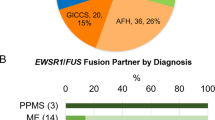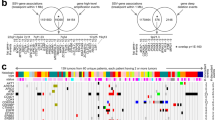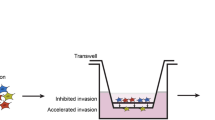Abstract
Genomic translocations have been implicated in cancer. In this study, we performed a screen for genetic translocations in gliomas based on exon-level expression profiles. We identified a translocation in the contactin-associated protein-like 2 (CASPR2) gene, encoding a cell adhesion molecule. CASPR2 mRNA was fused to an expressed sequence tag that likely is part of the nuclear receptor coactivator 1 gene. Despite high mRNA expression levels, no CASPR2 fusion protein was detected. In a set of 25 glioblastomas and 22 oligodendrogliomas, mutation analysis identified two additional samples with genetic alterations in the CASPR2 gene and all three identified genetic alterations are likely to reduce CASPR2 protein expression levels. Methylation of the CASPR2 gene was also observed in gliomas and glioma cell lines. CASPR2-overexpressing cells showed decreased proliferation rates, likely because of an increase in apoptosis. Moreover, high CASPR2 mRNA expression level is positively correlated with survival and is an independent prognostic factor. These results indicate that CASPR2 acts as a tumor suppressor gene in glioma.
This is a preview of subscription content, access via your institution
Access options
Subscribe to this journal
Receive 50 print issues and online access
$259.00 per year
only $5.18 per issue
Buy this article
- Purchase on Springer Link
- Instant access to full article PDF
Prices may be subject to local taxes which are calculated during checkout





Similar content being viewed by others
References
Alarcon M, Abrahams BS, Stone JL, Duvall JA, Perederiy JV, Bomar JM et al. (2008). Linkage, association, and gene-expression analyses identify CNTNAP2 as an autism-susceptibility gene. Am J Hum Genet 82: 150–159.
Arking DE, Cutler DJ, Brune CW, Teslovich TM, West K, Ikeda M et al. (2008). A common genetic variant in the neurexin superfamily member CNTNAP2 increases familial risk of autism. Am J Hum Genet 82: 160–164.
Bakkaloglu B, O′Roak BJ, Louvi A, Gupta AR, Abelson JF, Morgan TM et al. (2008). Molecular cytogenetic analysis and resequencing of contactin associated protein-like 2 in autism spectrum disorders. Am J Hum Genet 82: 165–173.
Balss J, Meyer J, Mueller W, Korshunov A, Hartmann C, von Deimling A . (2008). Analysis of the IDH1 codon 132 mutation in brain tumors. Acta Neuropathol 116: 597–602.
Bralten LB, Kloosterhof NK, Gravendeel LA, Sacchetti A, Duijm EJ, Kros JM et al. (2010). Integrated genomic profiling identifies candidate genes implicated in glioma-genesis and a novel LEO1-SLC12A1 fusion gene. Genes Chromosomes Cancer 49: 509–517.
Bredel M, Bredel C, Juric D, Harsh GR, Vogel H, Recht LD et al. (2005). High-resolution genome-wide mapping of genetic alterations in human glial brain tumors. Cancer Res 65: 4088–4096.
Clark TA, Schweitzer AC, Chen TX, Staples MK, Lu G, Wang H et al. (2007). Discovery of tissue-specific exons using comprehensive human exon microarrays. Genome Biol 8: R64.
Collier LS, Carlson CM, Ravimohan S, Dupuy AJ, Largaespada DA . (2005). Cancer gene discovery in solid tumours using transposon-based somatic mutagenesis in the mouse. Nature 436: 272–276.
Denisenko-Nehrbass N, Oguievetskaia K, Goutebroze L, Galvez T, Yamakawa H, Ohara O et al. (2003). Protein 4.1B associates with both Caspr/paranodin and Caspr2 at paranodes and juxtaparanodes of myelinated fibres. Eur J Neurosci 17: 411–416.
Freire P, Vilela M, Deus H, Kim YW, Koul D, Colman H et al. (2008). Exploratory analysis of the copy number alterations in glioblastoma multiforme. PLoS One 3: e4076.
French PJ, Peeters J, Horsman S, Duijm E, Siccama I, van den Bent MJ et al. (2007). Identification of differentially regulated splice variants and novel exons in glial brain tumors using exon expression arrays. Cancer Res 67: 5635–5642.
French PJ, Swagemakers SM, Nagel JH, Kouwenhoven MC, Brouwer E, van der Spek P et al. (2005). Gene expression profiles associated with treatment response in oligodendrogliomas. Cancer Res 65: 11335–11344.
Friedman JI, Vrijenhoek T, Markx S, Janssen IM, van der Vliet WA, Faas BH et al. (2008). CNTNAP2 gene dosage variation is associated with schizophrenia and epilepsy. Mol Psychiatry 13: 261–266.
Gerber MA, Bahr SM, Gutmann DH . (2006). Protein 4.1B/differentially expressed in adenocarcinoma of the lung-1 functions as a growth suppressor in meningioma cells by activating Rac1-dependent c-Jun-NH(2)-kinase signaling. Cancer Res 66: 5295–5303.
Gravendeel AM, van Kouwenhoven MCM, Gevaert O, de Rooi JJ, Stubbs AP, Duijm JE et al. (2009). Intrinsic expression profiles of gliomas predict survival more strongly than histology. Cancer Res 69: 9065–9072.
Gutmann DH, Donahoe J, Perry A, Lemke N, Gorse K, Kittiniyom K et al. (2000). Loss of DAL-1, a protein 4.1-related tumor suppressor, is an important early event in the pathogenesis of meningiomas. Hum Mol Genet 9: 1495–1500.
Heisterkamp N, Stam K, Groffen J, de Klein A, Grosveld G . (1985). Structural organization of the bcr gene and its role in the Ph′ translocation. Nature 315: 758–761.
Horresh I, Poliak S, Grant S, Bredt D, Rasband MN, Peles E . (2008). Multiple molecular interactions determine the clustering of Caspr2 and Kv1 channels in myelinated axons. J Neurosci 28: 14213–14222.
Jackman C, Horn ND, Molleston JP, Sokol DK . (2009). Gene associated with seizures, autism, and hepatomegaly in an Amish girl. Pediatr Neurol 40: 310–313.
Jaworski J, Spangler S, Seeburg DP, Hoogenraad CC, Sheng M . (2005). Control of dendritic arborization by the phosphoinositide-3′-kinase-Akt-mammalian target of rapamycin pathway. J Neurosci 25: 11300–11312.
Kleihues P, Cavenee WK (eds). (2000). WHO Classification of Tumours: Pathology and Genetics of Tumours of the Nervous System. IARC Press: Lyon.
Kraus JA, Koopmann J, Kaskel P, Maintz D, Brandner S, Schramm J et al. (1995). Shared allelic losses on chromosomes 1p and 19q suggest a common origin of oligodendroglioma and oligoastrocytoma. J Neuropathol Exp Neurol 54: 91–95.
Lieberoth A, Splittstoesser F, Katagihallimath N, Jakovcevski I, Loers G, Ranscht B et al. (2009). Lewis(x) and alpha2,3-sialyl glycans and their receptors TAG-1, Contactin, and L1 mediate CD24-dependent neurite outgrowth. J Neurosci 29: 6677–6690.
Louis DN, Ohgaki H, Wiestler OD, Cavenee WK, Burger PC, Jouvet A et al. (2007). The 2007 WHO classification of tumours of the central nervous system. Acta Neuropathol 114: 97–109.
Maher CA, Kumar-Sinha C, Cao X, Kalyana-Sundaram S, Han B, Jing X et al. (2009). Transcriptome sequencing to detect gene fusions in cancer. Nature 458: 97–101.
McAvoy S, Ganapathiraju SC, Ducharme-Smith AL, Pritchett JR, Kosari F, Perez DS et al. (2007). Non-random inactivation of large common fragile site genes in different cancers. Cytogenet Genome Res 118: 260–269.
Ohgaki H, Kleihues P . (2005). Epidemiology and etiology of gliomas. Acta Neuropathol 109: 93–108.
Omura N, Li CP, Li A, Hong SM, Walter K, Jimeno A et al. (2008). Genome-wide profiling of methylated promoters in pancreatic adenocarcinoma. Cancer Biol Ther 7: 1146–1156.
Parsons DW, Jones S, Zhang X, Lin JC, Leary RJ, Angenendt P et al. (2008). An integrated genomic analysis of human glioblastoma multiforme. Science 321: 1807–1812.
Poliak S, Gollan L, Martinez R, Custer A, Einheber S, Salzer JL et al. (1999). Caspr2, a new member of the neurexin superfamily, is localized at the juxtaparanodes of myelinated axons and associates with K+ channels. Neuron 24: 1037–1047.
Poliak S, Salomon D, Elhanany H, Sabanay H, Kiernan B, Pevny L et al. (2003). Juxtaparanodal clustering of Shaker-like K+ channels in myelinated axons depends on Caspr2 and TAG-1. J Cell Biol 162: 1149–1160.
Schroeder A, Mueller O, Stocker S, Salowsky R, Leiber M, Gassmann M et al. (2006). The RIN: an RNA integrity number for assigning integrity values to RNA measurements. BMC Mol Biol 7: 3.
Schutte M, Elstrodt F, Bralten LB, Nagel JH, Duijm E, Hollestelle A et al. (2008). Exon expression arrays as a tool to identify new cancer genes. PLoS One 3: e3007.
Smith DI, McAvoy S, Zhu Y, Perez DS . (2007). Large common fragile site genes and cancer. Semin Cancer Biol 17: 31–41.
Strauss KA, Puffenberger EG, Huentelman MJ, Gottlieb S, Dobrin SE, Parod JM et al. (2006). Recessive symptomatic focal epilepsy and mutant contactin-associated protein-like 2. N Engl J Med 354: 1370–1377.
Thorell K, Bergman A, Caren H, Nilsson S, Kogner P, Martinsson T et al. (2009). Verification of genes differentially expressed in neuroblastoma tumours: a study of potential tumour suppressor genes. BMC Med Genomics 2: 53.
Tomlins SA, Rhodes DR, Perner S, Dhanasekaran SM, Mehra R, Sun XW et al. (2005). Recurrent fusion of TMPRSS2 and ETS transcription factor genes in prostate cancer. Science 310: 644–648.
Tran Y, Benbatoul K, Gorse K, Rempel S, Futreal A, Green M et al. (1998). Novel regions of allelic deletion on chromosome 18p in tumors of the lung, brain and breast. Oncogene 17: 3499–3505.
Verkerk AJ, Mathews CA, Joosse M, Eussen BH, Heutink P, Oostra BA et al. (2003). CNTNAP2 is disrupted in a family with Gilles de la Tourette syndrome and obsessive compulsive disorder. Genomics 82: 1–9.
Vernes SC, Newbury DF, Abrahams BS, Winchester L, Nicod J, Groszer M et al. (2008). A functional genetic link between distinct developmental language disorders. N Engl J Med 359: 2337–2345.
Wachtel M, Dettling M, Koscielniak E, Stegmaier S, Treuner J, Simon-Klingenstein K et al. (2004). Gene expression signatures identify rhabdomyosarcoma subtypes and detect a novel t(2;2)(q35;p23) translocation fusing PAX3 to NCOA1. Cancer Res 64: 5539–5545.
Yan H, Parsons DW, Jin G, McLendon R, Rasheed BA, Yuan W et al. (2009). IDH1 and IDH2 mutations in gliomas. N Engl J Med 360: 765–773.
Zecchini S, Cavallaro U . (2010). Neural Cell Adhesion Molecule in Cancer: Expression and Mechanisms. Adv Exp Med Biol 663: 319–333.
Author information
Authors and Affiliations
Corresponding author
Ethics declarations
Competing interests
The authors declare no conflict of interest.
Additional information
Supplementary Information accompanies the paper on the Oncogene website
Supplementary information
Rights and permissions
About this article
Cite this article
Bralten, L., Gravendeel, A., Kloosterhof, N. et al. The CASPR2 cell adhesion molecule functions as a tumor suppressor gene in glioma. Oncogene 29, 6138–6148 (2010). https://doi.org/10.1038/onc.2010.342
Received:
Revised:
Accepted:
Published:
Issue Date:
DOI: https://doi.org/10.1038/onc.2010.342
Keywords
This article is cited by
-
PGBD5 promotes site-specific oncogenic mutations in human tumors
Nature Genetics (2017)
-
Tobacco smoking differently influences cell types of the innate and adaptive immune system—indications from CpG site methylation
Clinical Epigenetics (2016)
-
A Chinese female Morvan patient with LGI1 and CASPR2 antibodies: a case report
BMC Neurology (2016)
-
PI3 kinase mutations and mutational load as poor prognostic markers in diffuse glioma patients
Acta Neuropathologica Communications (2015)
-
Tumor-specific mutations in low-frequency genes affect their functional properties
Journal of Neuro-Oncology (2015)



